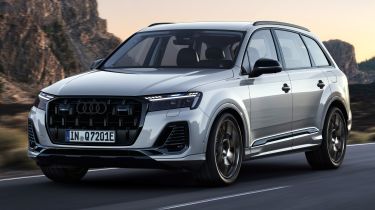New Audi Q7 facelift brings back plug-in hybrid power
Fresh technology has been added to Audi’s largest SUV for 2024

Earlier this year we saw the Audi Q7 large luxury SUV receive its second facelift, although there was a significant omission of the plug-in hybrid variant. Now, the Q7 plug-in hybrid is back having been available on and off since the current Q7 launched in 2015. For the latest plug-in iteration Audi has thrown as much technology at the large SUV as it could.
Audi is planning to move away from its confusing badging strategy, but this obviously hasn’t come into place just yet and plug-in hybrid buyers will still be confronted by the Audi Q7 55 TFSI e quattro. As before it’ll take aim squarely at the BMW X5 xDrive50e and Mercedes GLE 400 e plug-in hybrids and to a lesser extent, a growing range of similarly-sized, all-electric luxury SUVs.
Powering the Q7 55 TFSI e is a 3.0-litre six-cylinder petrol engine with 334bhp - the same as you’d find in the mild-hybrid V6 petrol Q7. In the PHEV, this is mated to an electric motor with 174bhp and 460Nm of torque, featuring a more powerful 25.9kWh battery under the boot floor. That’s much more than the old Q7 60 TFSI e’s 17.3kWh battery, meaning all-electric range has doubled from 26 miles to 52 miles.
Total power output of the Q7 PHEV is 388bhp and 600Nm of torque, enabling a 0-62mph time of 5.7 seconds before the SUV tops out at 149mph (the electric-only top speed is 84mph). The maximum charge rate for the battery is 7.4kW with a 0-100 per cent recharge taking three hours and 45 minutes.
It’s possible to recharge the battery a little on the move by recovering energy through the braking system. Rechagring only occurs above 40mph and with the driving mode set to ‘charge’ - this mode isn’t offered when the battery has reached 75 per cent of its charge to preserve its health and efficiency.
The Audi Q7 PHEV sits on air suspension and new to the model in 2024 is rear-wheel steering which turns the rear wheels up to five degrees in the opposite direction to the fronts, reducing the turning radius by one metre and boosting manoeuvrability, according to Audi. The electromechanical active roll stabilisation is another new feature and it is said to help reduce body roll while also providing a more precise steering response.
As standard the Q7 PHEV gets matrix LED headlights with the Q7’s new running light signature, a rear view camera, Audi’s ‘Virtual Cockpit plus’ and three-zone automatic climate control.
Pricing for the Q7 plug-in hybrid hasn’t been revealed yet although we expect it to start from around £75,000 with the top-spec Vorsprung versions sitting near the £100,000 mark.
Can't wait for the new Q7? These are the best large SUVs to buy right now...
Find a car with the experts








